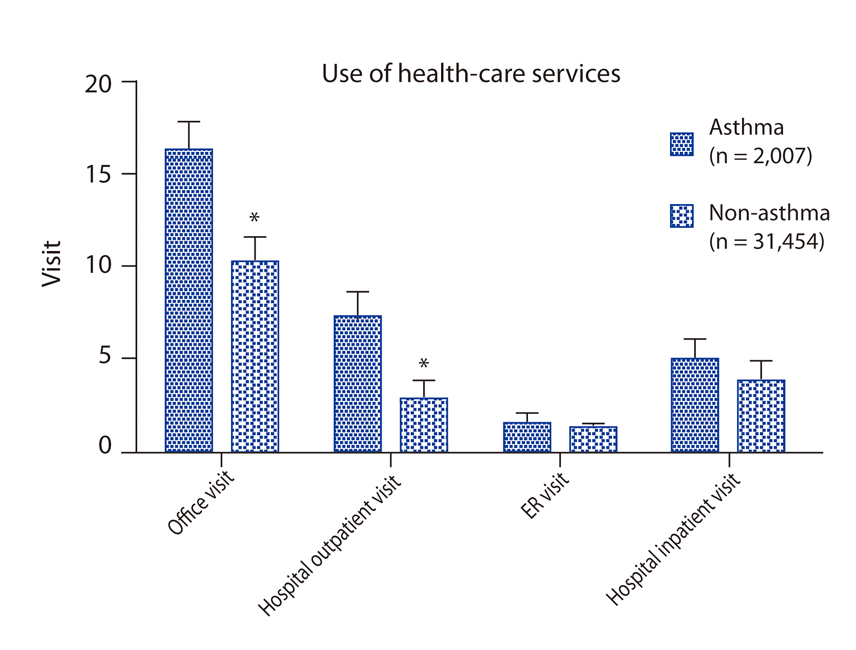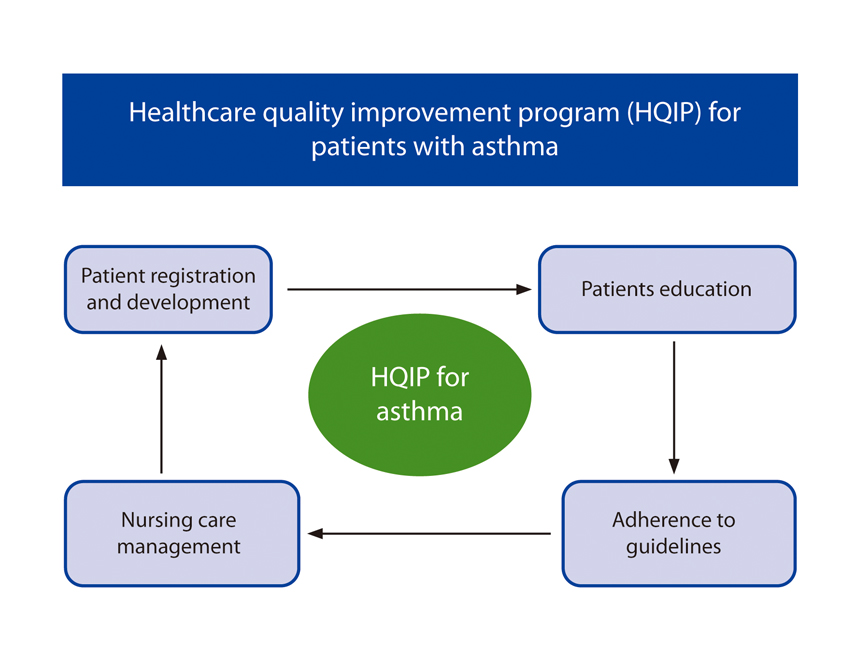Asia Pac Allergy.
2012 Jul;2(3):167-171. 10.5415/apallergy.2012.2.3.167.
Health care utilization and medical costs for childhood asthma in Taiwan: using Taiwan National Health Insurance Research Database
- Affiliations
-
- 1Division of Allergy and Clinical Immunology, Department of Pediatrics, College of Medicine, National Cheng Kung University Medical Center, Tainan 70428, Taiwan. a122@mail.ncku.edu.tw
- 2Institute of Gerontology, College of Medicine, National Cheng Kung University Medical Center, Tainan 70428, Taiwan.
- KMID: 2397478
- DOI: http://doi.org/10.5415/apallergy.2012.2.3.167
Abstract
- Asthma is an important health problem worldwide and the prevalence is increasing in most part of the world. The burden of this disease to governments, health-care systems, and patients and their families have been greater more than ever despite efforts advocated by Global Initiative for Asthma for total asthma controls. Using Taiwan National Health Insurance Research Database, in this review, the population-based prospective studies showed the costs and health care utilization of childhood asthma in Taiwan was 2 folds higher than non-asthmatic children, and the prescription patterns of anti-asthmatic medications among physician in different discipline were all far from satisfied. The appropriateness of combinational therapy of inhaled corticosteroids and long acting β-agonists for moderate to severe childhood asthma was only 62%. In a government-sponsored disease management program for asthmatic patients within national health insurance, though the total mean costs (26.5%) and outpatient costs (26.1%) increased, the mean emergency department visits and hospitalization rates were significantly reduced by 34.4% and 51.74%, respectively, compared to the previous year. Therefore, in the real-world situation, asthmatic patients as well as medical professions who take care of asthmatic children still have much space for their symptoms controls and knowledge improvement to reduce the burden of asthma. From the experience of care and management of childhood asthma in Taiwan may reveal same problems of childhood asthma care in the similar cultural and ecological environments of Asian pacific countries, and suggest government-sponsored program may also have significant impact aimed at improving the care of patients with asthma.
MeSH Terms
-
Adrenal Cortex Hormones
Asian Continental Ancestry Group
Asthma*
Child
Delivery of Health Care*
Disease Management
Emergency Service, Hospital
Government Programs
Hospitalization
Humans
National Health Programs*
Outpatients
Patient Acceptance of Health Care*
Prescriptions
Prevalence
Prospective Studies
Taiwan*
Adrenal Cortex Hormones
Figure
Cited by 2 articles
-
In this issue of Asia Pacific Allergy
Sang-Heon Cho
Asia Pac Allergy. 2012;2(3):165-166. doi: 10.5415/apallergy.2012.2.3.165.What Taiwan contributes to the world of allergy and clinical immunology?
Jiu-Yao Wang
Asia Pac Allergy. 2013;3(4):209-214. doi: 10.5415/apallergy.2013.3.4.209.
Reference
-
1. Pearce N, Aït-Khaled N, Beasley R, Mallol J, Keil U, Mitchell E, Robertson C. Worldwide trends in the prevalence of asthma symptoms: phase III of the International Study of Asthma and Allergies in Childhood (ISAAC). Thorax. 2007. 62:758–766.
Article2. Asher MI, Montefort S, Björkstén B, Lai CK, Strachan DP, Weiland SK, Williams H. Worldwide time trends in the prevalence of symptoms of asthma, allergic rhinoconjunctivitis, and eczema in childhood: ISAAC Phases One and Three repeat multicountry cross-sectional surveys. Lancet. 2006. 368:733–743.
Article3. Hsieh KH, Shen JJ. Prevalence of childhood asthma in Taipei, Taiwan, and other Asian Pacific countries. J Asthma. 1988. 25:73–82.
Article4. Wu WF, Wan KS, Wang SJ, Yang W, Liu WL. Prevalence, severity, and time trends of allergic conditions in 6-to-7-year-old schoolchildren in Taipei. J Investig Allergol Clin Immunol. 2011. 21:556–562.5. Department of Health. Health and vital statistics Republic of China, 1981-2002. 2003. Taipei: Department of Health.6. Centers for Disease Control and Prevention. National Center for Health Statistics. Available from: http://www.cdc.gov/nchs/fastats/asthma.htm.7. Centers for Disease Control and Prevention. Disabilities among children aged less than or equal to 17 years -- United States, 1991-1992. MMWR Morb Mortal Wkly Rep. 1995. 44:609–613.8. Newacheck PW, Budetti PP, Halfon N. Trends in activity-limiting chronic conditions among children. Am J Public Health. 1986. 76:178–184.
Article9. Homer CJ, Szilagyi P, Rodewald L, Bloom SR, Greenspan P, Yazdgerdi S, Leventhal JM, Finkelstein D, Perrin JM. Does quality of care affect rates of hospitalization for childhood asthma? Pediatrics. 1996. 98:18–23.
Article10. National Asthma Education and Prevention Program: Expert Panel Report 2. Guidelines for the diagnosis and management of asthma. 1997. Bethesda: National Heart, Lung, and Blood Institute.11. Sly RM. Decreases in asthma mortality in the United States. Ann Allergy Asthma Immunol. 2000. 85:121–127.
Article12. Newacheck PW, Halfon N. Prevalence, impact, and trends in childhood disability due to asthma. Arch Pediatr Adolesc Med. 2000. 154:287–293.
Article13. Akinbami LJ, Schoendorf KC. Trends in childhood asthma: prevalence, health care utilization, and mortality. Pediatrics. 2002. 110:315–322.
Article14. Bureau of National Health Insurance. National Health Insurance Annual Statistical Report. 2001. Taipei: Bureau of National Health Insurance.15. Hsiao FY, Yang CL, Huang YT, Huang WF. Using Taiwan's National Health Insurance Research Databases for pharmacoepidemiology research. J Food Drug Anal. 2007. 15:99–108.
Article16. Weiss KB, Sullivan SD, Lyttle CS. Trends in the cost of illness for asthma in the United States, 1985-1994. J Allergy Clin Immunol. 2000. 106:493–499.
Article17. Gergen PJ. Understanding the economic burden of asthma. J Allergy Clin Immunol. 2001. 107:S445–S448.
Article18. Sun HL, Kao YH, Lu TH, Chou MC, Lue KH. Health-care utilization and costs in Taiwanese pediatric patients with asthma. Pediatr Int. 2007. 49:48–52.
Article19. Gypmantasiri S. Costs of illness of asthma in Chiang Mai and Lumphun. Chiang Mai Univ J Econ. 2007. 11:1–9.20. Chew FT, Goh DY, Lee BW. The economic cost of asthma in Singapore. Aust N Z J Med. 1999. 29:228–233.
Article21. Mellon M, Parasuraman B. Pediatric asthma: improving management to reduce cost of care. J Manag Care Pharm. 2004. 10:130–141.
Article22. Sun HL, Lue KH. Health care utilization and costs of adult asthma in Taiwan. Allergy Asthma Proc. 2008. 29:177–181.
Article23. Global Initiative for Asthma. NHLBI/WHO workshop report: global strategy for asthma management and prevention (revised 2009). Available from: http://www.ginasthma.com.24. Sun HL, Kao YH, Chou MC, Lu TH, Lue KH. Differences in the prescription patterns of anti-asthmatic medications for children by pediatricians, family physicians and physicians of other specialties. J Formos Med Assoc. 2006. 105:277–283.
Article25. Lozano P, Sullivan SD, Smith DH, Weiss KB. The economic burden of asthma in US children: estimates from the National Medical Expenditure Survey. J Allergy Clin Immunol. 1999. 104:957–963.
Article26. Shrewsbury S, Pyke S, Britton M. Meta-analysis of increased dose of inhaled steroid or addition of salmeterol in symptomatic asthma (MIASMA). BMJ. 2000. 320:1368–1373.
Article27. Lazarus SC, Boushey HA, Fahy JV, Chinchilli VM, Lemanske RF Jr, Sorkness CA, Kraft M, Fish JE, Peters SP, Craig T, Drazen JM, Ford JG, Israel E, Martin RJ, Mauger EA, Nachman SA, Spahn JD, Szefler SJ. Long-acting beta2-agonist monotherapy vs continued therapy with inhaled corticosteroids in patients with persistent asthma: a randomized controlled trial. JAMA. 2001. 285:2583–2593.28. Weng HC. Impacts of a government-sponsored outpatient-based disease management program for patients with asthma: a preliminary analysis of national data from Taiwan. Dis Manag. 2005. 8:48–58.
Article29. Weng HC, Yuan BC, Su YT, Perng DS, Chen WH, Lin LJ, Chi SC, Chou CH. Effectiveness of a nurse-led management programme for paediatric asthma in Taiwan. J Paediatr Child Health. 2007. 43:134–138.
Article
- Full Text Links
- Actions
-
Cited
- CITED
-
- Close
- Share
- Similar articles
-
- Data resource profile: the National Health Insurance Research Database (NHIRD)
- Direction of Health Care and Health Insurance System Reform to Strengthen Primary Care: Comparative Analysis of Korea, Japan and Taiwan
- Health Care Utilization and Expenditures of Patients with Diabetes Comorbid with Depression Disorder: A National Population-Based Cohort Study
- Cost-of-illness Study of Asthma in Korea: Estimated from the Korea National Health Insurance Claims Database
- Aspergillus sensitization associated with current asthma in children in the United States: an analysis of data from the 2005-2006 NHANES



